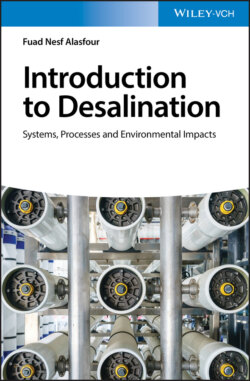Читать книгу Introduction to Desalination - Fuad Nesf Alasfour - Страница 24
1.5 Which Desalination System Is the Best?
ОглавлениеRecall that feed type, characteristics, and quality play a major role in selecting desalination system. In addition potable water purity, type of energy consumption, water production cost, and emissions are also factors that play a role during desalination technology selecting; engineers must evaluate all the mentioned parameters to optimize his or her selection process.
For example, if we take a case of 45 000 ppm feed seawater, thermal system can be used, while in other cases such as brackish water with 8000 ppm salinity, membrane system is recommended. In certain applications using two different combined desalination system, thermal and membrane, which is called hybrid (Chapter 10), is another option of selection.
Table 1.1 shows the range operational energy requirement for main desalination systems.
Table 1.1 Energy requirement for main desalination systems.
Source: Alkaisi et al. 2017 [4]. Reproduced with permission of Elsevier.
| MEE | MSF | MEE‐TVC | MVC | RO | ED | |
| Typical unit size (m3/d) | 5000–15 000 | 50 000–70 000 | 10 000–35 000 | 100–2500 | 24 000 | −145 000 |
| Steam pressure (atm) | 0.2–0.4 | 2.5–3.5 | 0.2–0.4 | — | — | — |
| Electrical energy consumption (kWh/m3) | 1.5–2.5 | 4–6 | 1.5–2.5 | 7–12 | 3–7 | 2.6–5.5 |
| Thermal energy consumption (kJ/kg) | 230–390 | 190–390 | 145–390 | None | None | None |
| Electrical equivalent for thermal energy (kWh/m3) | 5–8.5 | 9.5–19.5 | 9.5–25.5 | None | None | None |
| Total equivalent energy consumption (kWh/m3) | 6.5–11 | 13.5–25.5 | 11–28 | 7–12 | 3–7 | 26–5.5 |
